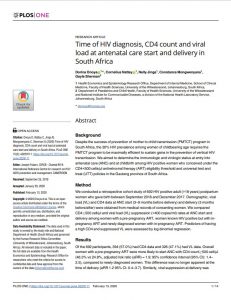
Background
Despite the success of prevention of mother to child transmission (PMTCT) program in South Africa, the 30% HIV prevalence among women of childbearing age requires the PMTCT program to be maximally efficient to sustain gains in the prevention of vertical HIV transmission. We aimed to determine the immunologic and virologic status at entry into antenatal care (ANC) and at childbirth among HIV positive women who conceived under the CD4<500 cells/μl antiretroviral therapy (ART) eligibility threshold and universal test and treat (UTT) policies in the Gauteng province of South Africa.
Method
We conducted a retrospective cohort study of 692 HIV positive adult (>18 years) postpartum women who gave birth between September 2016 and December 2017. Demographic, viral load (VL) and CD4 data at ANC start (3–9 months before delivery) and delivery (3 months before/after) were obtained from medical records of consenting women. We compared CD4 500 cell/μl and viral load (VL) suppression (<400 copes/ml) rates at ANC start and delivery among women with a pre-pregnancy ART, women known HIV positive but with inpregnancy ART and newly diagnosed women with in-pregnancy ART. Predictors of having a high CD4 and suppressed VL were assessed by log-binomial regression.
Results
Of the 692 participants, 394 (57.0%) had CD4 data and 326 (47.1%) had VL data. Overall women with a pre-pregnancy ART were more likely to start ANC with CD4 count 500 cell/μl (46.3% vs 24.8%, adjusted risk ratio (aRR) = 1.9; 95% confidence interval (95% CI): 1.4– 2.5), compared to newly diagnosed women. This difference was no longer apparent at the time of delivery (aRR 1.2 95% CI: 0.4–3.7). Similarly, viral suppression at delivery was higher among women with pre-pregnancy ART (87.2% vs 69.3%, aRR 1.3, 95% CI: 1.1–1.6) as compared to the newly diagnosed women. Viral suppression rate among newly diagnosed women increased substantially by the time of delivery from 43.5% to 69.3% (p = 0.001).
Conclusion
These results show that pre-pregnancy ART improves immunologic and virologic control during pregnancy and call for renewed efforts in HIV testing, linkage to ART and viral monitoring.